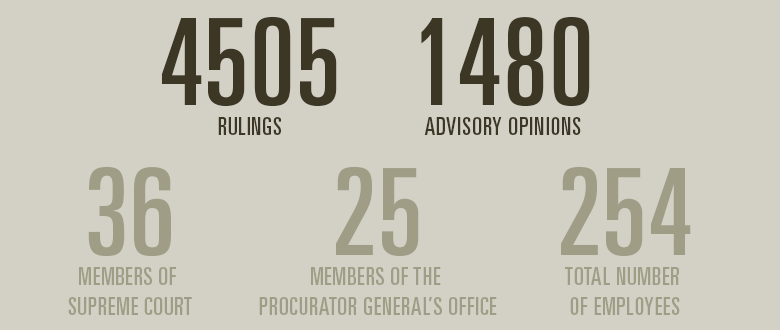Introduction
In this annual report, the Supreme Court and the Procurator General’s Office at the Supreme Court publicly account for their work and use of resources in 2020.
A complex society cannot function if it is not regulated by law. Legislation and its implementation determine the broad outlines in a parliamentary democracy whose legitimacy is derived from the electorate. The administration of justice often centres on the application of the law and the settlement of disputes between individuals. The way in which dispute settlement is conducted and the law is applied must be visibly independent of the parties, while respecting the legislature and taking account of fundamental rights. The judicial system plays a vital role in society. That is certainly true in the middle of a pandemic during which legal claims, lodged on the basis of surprising new arguments, often demand urgent solutions.
This annual report will be published during the COVID-19 pandemic. In retrospect, the 2019 annual report appeared at the beginning of a global health crisis. In 2020 the Supreme Court did everything in its power to ensure that the courts could continue to function within the constraints imposed by the coronavirus restrictions. Both experience and the figures for 2020 show that the Court continued to operate well during the pandemic. How it managed to do so is described in the section entitled ‘2020: the year in which the health crisis began’.
In ‘The Supreme Court’s key tasks’, we examine the Court’s tasks in relation to the uniformity of the law, the development of the law and legal protection. None of these three tasks can be properly performed in isolation.
‘Contact with the legislature’ deals with the relationship between the Supreme Court’s key tasks and the legislature. This section also highlights the judgments in which the Court drew the legislature’s attention to a particular issue in 2020.
‘Contact with the public’ focuses on how the Court informs and communicates with society as a whole. Since its establishment in 1838, the Supreme Court has been an authoritative institution within our democracy governed by the rule of law. Good communication between the Supreme Court and the public is of vital importance if the Court is to move with the times as it discharges its judicial function. The Court aims to be a visible, approachable and recognisable part of society, while maintaining the necessary distance to remain independent and authoritative within the legislative framework, for example in the case of public controversy. In recent years, communication with the public has intensified. This section describes how the Supreme Court developed that communication in 2020.
In 2020 a new Supreme Court president was appointed. On 1 November 2020 President Maarten Ferris stepped down after the customary six-year term of office. His successor, Dineke de Groot, is the first woman to become president of the Court since its establishment in 1838. As a result of the coronavirus restrictions, the farewell ceremony for the outgoing president and the new president’s inauguration were live-streamed, enabling more people than ever to watch the event. The section entitled ‘President and Procurator General’ provides more information about these two posts, the responsibilities they entail and how they relate to each other.
This annual report also discusses a number of cases from each area of law in which the Supreme Court gave judgment in the past year and which were important for the uniformity and the development of the law and for legal protection, or which were socially relevant in some other way. These are included, together with the figures relating to the area of law concerned, in the sections on the three divisions of the Court.
Another section of this annual report, entitled ‘The Procurator General’s Office’, is concerned with the activities of the Procurator General and his Office during the reporting period. The most important task of the Office is to provide the Supreme Court with expert legal advice, known as advisory opinions, in the cases before the Court. This section gives further details of this activity and focuses in addition on the Procurator General’s special responsibilities.
Finally, this annual report discusses external and internal complaints lodged this year and the key figures for 2020.
